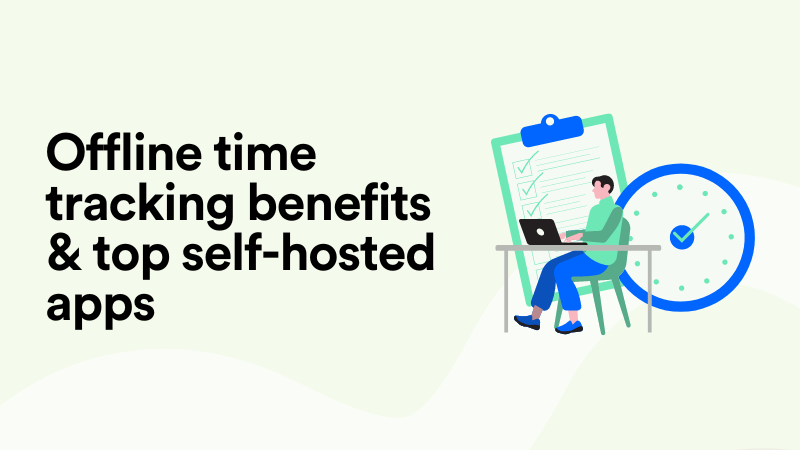Employee Monitoring Is Dumb. Try Other Proven Ways to Sink Your Ops

If you’re looking for a good villain origin story, consider employee monitoring. You’ll be despised by some, feared by many, and resented by everyone else.
But you never wanted to be a villain, have you? You were only trying to fix your productivity problem. And because your team can’t be trusted, you had no choice but to resort to employee monitoring.
Spoiler alert: it did the opposite of what it was supposed to do.
Off the bat, some detrimental effects of workplace surveillance include:
- Anxiety and resentment
- Low morale
- Lack of autonomy and creativity
- High risk of burnout
- High employee turnover
- Difficulty attracting talent
Meanwhile, all you ever wanted was to fix performance issues by taking control of your team’s time. Only to land yourself the title of “Worst Boss Ever”.
How come employee monitoring exists?
If employee surveillance is so bad, how come it’s still a thing? Managers can’t be that dumb, there must be something to gain from it.
Like all morally ambiguous things, employee monitoring started off innocent but didn’t age well.
Think industrial revolution. Think time clocks and punch cards. Workers had to show up in the morning and do their shifts for the industrial complex to keep rolling along.
In a time and material (T&M) model used by many service businesses to this day, you are paid according to your factual contribution. When we talk about skilled labor, contribution is most commonly measured in the hours you put in.
Additionally, tracking work time can be used to reward punctuation and compensate employees fairly for overtime. Nothing evil here, is it?
Work time tracking is not evil in and of itself. It gets problematic as it becomes unethical and steps into employee surveillance territory.
New dawn in workplace surveillance

Among other horrible things, the year 2020 marked a new dawn in employee surveillance. Remote work and employee monitoring go hand in hand, at least for those managers who didn’t trust their people to begin with.
And so they rolled in – a slew of employee monitoring solutions disguised under different names (it gets progressively worse):
- Time tracking
- Productivity tracking
- Activity tracking
- Desktop monitoring
- Screen recording
One industry report suggests that the global employee monitoring software market valued at USD 1.12 billion in 2021 is expected to reach USD 2.10 billion by 2030. Even amidst many workers returning to on-site office settings.
Champions of employee monitoring tools are likely to be firm believers in an 8-hour workday with 90%+ utilization rate. I.e. at least 90% of employees’ time should be spent on “billable” or revenue-generating tasks.
The only way to ensure that, especially in a remote work environment, is through rigorous monitoring of employee activity throughout the day. Because nobody can be trusted.
The real cost of employee monitoring
When was the last time the feeling of being watched made you do a better job? If anything, you completed a small, non-creative task faster – at the expense of never wanting to do it again.
The business rationale behind employee surveillance is to get more work done in a shorter amount of time. What capitalist doesn’t want to maximize output while keeping the cost of labor the same?
The irony is that people never worked 40 hours a week. As in, delivered value and contributed to revenue for 8 hours a day, 5 days in a row.
There’s coffee breaks, lunch breaks, bathroom breaks, smoke breaks, watercooler and printer chats – all of these are sanctioned in an office setting. Then there’s good old slacking, doomscrolling, and whatever normal human behaviors are permitted at your office.
With all this going on, empires died and unicorns were born. Meanwhile, some companies still favor perfect attendance over creativity, innovation, and growth.
The real cost of employee monitoring is measured in trust lost, timesheets data faked, and talent longing for a better work culture. Naturally, this all translates to a lower quality of work and a higher employee turnover.
Trust issues much?

Ultimately, the phenomenon of employee monitoring boils down to the question of trust vs control. How much you can trust your employees to do a good job vs how much control you need to exercise to get the job done.
This wouldn’t be a question if there weren’t performance issues to address, some managers might say. True, but the way you approach these issues sets the stage for the kind of culture you breed. One of surveillance and discipline or trust and creativity.
Trust means accountability for results and the freedom to execute on your own terms. If taking a midday break from 3-5 pm is what a person needs to recuperate and work productively from 5-7 pm, so be it. As long as the person can deliver on time and contribute meaningfully to larger business goals.
If you want motivated employees and not corporate slaves, your response should be to sit on the same side of the table with your team and get everyone involved in coming up with a solution.
When you trust your employees, they can be honest with you about which tasks, services, and projects are truly profitable, i.e. take adequate time compared to the revenue generated. Simply because we all share an interest in having job security.
What makes a man(ager)
Employees are smarter than you think. You can be transparent with them about your profitability issues and the importance of everyone's involvement.
As a manager, you’re allowed to be stubborn and advocate for employee monitoring all you want. But is this the hill you choose to die on? After all, it’s not even a case of an end that justifies the means, because workplace surveillance never ends well.
The age of employee monitoring is over. It’s tired, creepy, and does the opposite of what it’s meant to do.
If you really want to fix your productivity problem, focus on what's proven to work: salary, recognition, and meaningful feedback.
Yulia Miashkova
Yulia Miashkova is a content creator with 7 years of hands-on experience in B2B marketing. Her background is in public relations, SEO, social listening, and ABM. Yulia writes about technology for business growth, focusing on automated time tracking solutions for digital teams. In her spare time Yulia is an avid reader of contemporary fiction, adamant runner, and cold plunge enthusiast.







